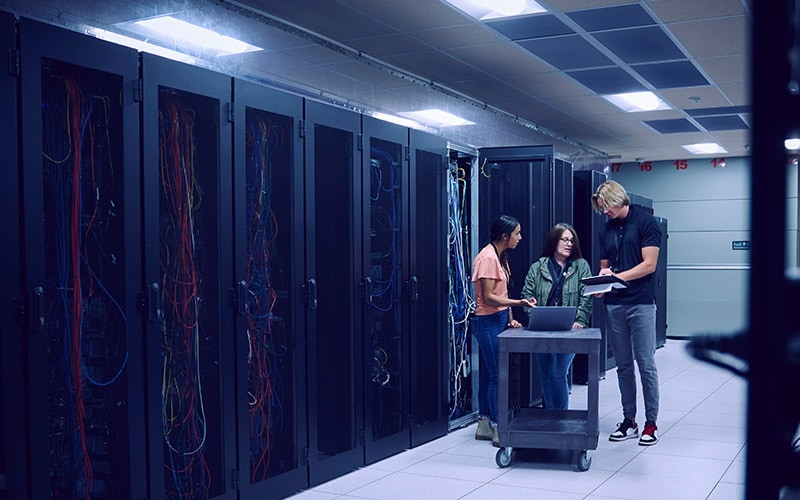Insights
- As cloud capabilities grow, so do costs associated with cloud, driven by artificial intelligence platforms and changes in pricing structures for fundamental cloud services.
- Cloud-based artificial intelligence platforms proliferate, which will require more strategic thinking in terms of cloud operating model and architecture strategies.
- Regulation and resilience will require more resources and attention, as regulators lay out new rules and hackers raise the stakes for companies.
- AI and new standards of interoperability will boost the relevance of edge cloud and Internet-of-Things.
In the past 20 years, cloud has become a mainstay of enterprise computing. Although we still call it cloud, much has changed. Cloud in 2025 will resemble 2005 cloud only around the edges. This is because enterprise cloud computing is constantly changing and improving. These shifts are difficult to perceive at the outset but have led to drastic changes in cloud tech stacks and workflows.
For example, containers existed in the early days of corporate cloud, but only became a fundamental cloud infrastructure component in the 2010s. The development of Docker and adoption of Kubernetes took time but have remade how enterprises use cloud.
Here are seven developments that could be cloud game-changers in 2025:
1. The end of perpetual licenses is the beginning of serious cloud operating model talks
Broadcom’s move to end perpetual licenses for VMWare after it closed its acquisition of the essential virtualization tool in 2023 met with resistance, complaints, and lawsuits in 2024. In the coming year, companies will face a serious decision: Pay more on a subscription basis, find alternative services, or shift workloads back to on-premises hardware.
Smart companies will pursue a middle path: Studying their usage and refining their cloud operating model. When enterprises switch to cloud, they can have greater transparency in pricing if they want to dig into the details. But transparency doesn’t mean simple. Cloud and cloud-based enterprise software providers charge based on consumption and/or by seat subscriptions, each of which can vary widely with business fluctuations.
A cloud operating model aligns cloud tech costs with business requirements. This allows tech and business leaders to build strategies that deliver cloud services that scale with business activity without breaking the bank.
For cases where companies use cloud services for transactions, alignment is simple. More transactions cover greater costs. But when the value of the cloud service is more ephemeral, alignment requires more thought. As Infosys’s Madhanraj Jeyapragasam first posted on LinkedIn.
“Consumption-based pricing for a transactional system can be easily linked to business operations. Cost and gain should [be linked] in terms of efficiency. But for an analytical system which drives growth, the consumption-based pricing model would face some headwinds and needs more work.”
Implications for the enterprise: It’s time for business leaders to gain some understanding of IT and cloud and their evolving pricing structures, and it’s time for IT leaders to gain understanding of business strategies and what growth and volatility will require from cloud and IT services. With that shared knowledge, the enterprise can develop a cloud-biz center of excellence with the proper ingredients to develop a cloud operating model.
2. AI pushes cloud away from the lift and shift
In the AI realm, large language models have given way toward more useful narrow learning models. Relevant training for AI is emerging as a critical capability, and access to interoperable data is the catalyst. The trouble is that most enterprises are not ready for AI. More specifically, only 17% of organizations have data prepared for AI, in terms of access, accuracy, and governance, Infosys Knowledge Institute research has found.
AI is expensive, and most effective when organizations to an AI-first approach. In cloud, that means integrated, interoperable, and refactored. Lift-and-shift silos that work for their own purposes will be exposed and targeted for refactoring. If it’s worth doing AI, it’s worth modernizing the cloud.
But critically, AI needs the right data to be useful. Simultaneous to modernization, companies must verify that cloud is generating data that will be useful. To an AI camera, a block of aluminum and a block of lead could both be classified as metal masses. But for a shipping business, it’s the weight of the blocks that is most critical.
Implications for the enterprise: AI is expensive and requires the right data and right context. Companies must decide what AI is for. With that in mind, they must look at their organization and determine how to modernize digital systems so that AI can deliver real ROI.
3. AI agents populate every cloud platform
Cloud platforms continue to add capabilities and reach further across the enterprise. At the top of the list of new capabilities will be AI-powered agents on every platform.
AWS, Google Cloud, Microsoft Azure, and Oracle all offer their own operations and telemetry agents. Software-as-a-service leaders on the customer, IT services, sales, and support sides all have agents available to enter the field.
In 2025, company leaders will see AI-powered agents taking on tech-stack tasks, ranging from cloud management, cybersecurity, multicloud orchestration, software development and automation, and edge computing. CTOs, CIOs, and their teams should spend time this year putting agents through their paces and carefully assessing value, cost, and effectiveness.
The next-level assessment will be agent interoperability — can one platform’s agent deliver relevant details across other platforms, services, and workloads to make a second or third agent redundant?
Implications for the enterprise: No one agent fits all, but here are three pathways. For an enterprise mostly operating in a singular cloud ecosystem, that ecosystem’s agent will be a best fit. For organizations with a mix of ecosystems, skip most of the new agents, and establish a data lake where a generalized agent or a home-brewed AI agent can take the lead. For data-thin companies and those with limits on what they can do with data, maybe an AI agent is not for you.
4. The emergence of sovereign cloud and data controls will drive cloud placement decisions
A confluence of political, technical, and economic factors is creating tailwinds for sovereign cloud computing services.
Regional data privacy rules and regulations are developing with various standards, and regional compliance on local cloud instances is a logical first step. The European Union’s Digital Operational Resilience Act (DORA) comes into force in January 2025. While it aims to strengthen IT security and resilience in the financial sector, the standards laid out for financial institutions and their technology and communications service providers will set the standards for other industries.
Second, globe-stopping outages, such as the summer 2024 CrowdStrike-Microsoft outage, raise the question: Is our global tech infrastructure too vulnerable? If the answer is yes, the reply underscores the value of risk management frameworks, resilience testing, and information sharing, particularly for digital transactions and financial services organizations. Third, local cloud can be a bit more green. Powerful cloud computing is terrific, but it’s also energy intensive. Regional mandates for energy-efficient data centers will be a way for local leaders to encourage tech investment and advocate for a healthier environment. For example, Norway’s Lefdal Mine Datacenter uses nearby fjords to cool servers and renewable power to offer a green and low-cost data center service.
Finally, sovereign cloud services can serve as a political firewall for data-hungry AI algorithms intent on hoovering up data, but not necessarily trained on data regulations and compliance standards from jurisdiction to jurisdiction. Microsoft has developed public cloud-based sovereign cloud controls that aim to encrypt data and create software-driven boundaries that comply with regional requirements and regulations.
All told, this has the makings of a challenge and an opportunity. Compliance on a region-to-region basis will be complex and challenging. Building a regionalized, resilient, and tunable cloud services infrastructure is, however, an opportunity to deliver better cloud capabilities across the enterprise.
Implications for enterprises: For multinational companies, data and sovereign cloud could shape up into an additional pillar in their cloud operating model. Where costs and business value keyed the first conversations, risk, compliance, data ethics, tariffs, and politics could enter the chat.
5. Edge cloud gets a boost from AI
Watch for edge computing and automation to receive a big boost from cloud-borne AI in 2025, which will be able to mine insights from the vast quantities of data generated from the edge more cost-effectively.
Although edge computing isn’t new, it has expanded, generating enormous amounts of data. For example, a modern car is, in many aspects, a moving semiautonomous edge cloud. Increasingly, the car cloud now interfaces with other edge instances, in the forms of tollway sensors and license plate readers.
The nexus of declining costs and new analysis will be a popular destination for data scientists and business leaders. New possibilities and new investment in old edge systems could be on the docket for the back half of 2025.
Implications for enterprises: Enterprises with extensive edge computing assets stand to benefit from a full census of their assets and arrays. This can be a first step toward fresh thinking on what’s at the edge and what value it can deliver.
6. Cyber resilience takes center stage
Data, AI, and cloud are at the essence of technology, highly digital non-tech companies and a widening array of institutions. Cyberattacks that hold essential data for ransom have paralyzed individual companies and whole industry segments.
In the UK, the 2023 British Library ransomware attack has focused minds, and the 2017 WannaCry attack left the National Health Service reeling. In the US in early 2024, a unit of healthcare services giant Optum suffered a cyberattack that halted the delivery of drug prescriptions. The lesson from many attacks and incidents is that you can’t put off digital transformation and upgrading old tech.
As mentioned above, the EU’s DORA rules will require banks, financial institutions, and related companies to abide by certain standards in information and communication technology (ICT). While good practices and principles around ICT have existed, this marks the first time they will be codified for a significant proportion of the world.
While the US lacks an analogous comprehensive act, a number of agencies and overseers are moving in that direction. The real question is whether they arrive before the black hats: Craigslist founder Craig Newmark fears they might not. He has offered hundreds of millions of dollars to protect American digital systems from cyberattacks.
Implications for the enterprise: It’s easy to see cyber-resiliency as another cost center and compliance exercise. But factor in the digital landscape’s pace of change and cyberattacks grow into an existential threat for data-reliant companies.
7. Cloud sustainability puts a new emphasis on efficiency
As cloud computing grows and the demand for data centers expands, the sustainability focus has shifted to those data centers and their power usage. Yes, efficiency gains from cloud computing power sourcing will help, but on a small scale relative to the potential AI and data in the cloud.
This spans industries and applies for companies with cloud compute needs large and small. An AI-derived insight that enables an insurer to process claims more quickly, save money, and operate more efficiently has several rounds of carbon footprint-shrinking impact. In manufacturing, this applies as well, and perhaps with a greater multiplier depending on the nature of the underlying company’s work.
But at the same time, increased AI usage comes with increased power demand. Google’s own emissions have climbed nearly 50% in five years as it has invested heavily in AI, making its goal of net zero emissions by 2030 more difficult. Companies will have to reconcile their rush to adopt AI with decarbonization goals.
Implications for the enterprise: In much of the world, sustainability reporting will continue to be a critical data point for companies. In addition to looking at the energy and carbon footprint required for cloud and AI, be sure to capture the efficiency and power savings gained from their novel insights.






